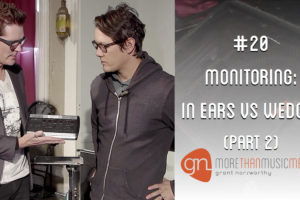Grant spoke with Dominic Schryvers from The Stations and the Gregorian Chat YouTube Channel about…
M3 VIDEO #3 – ELECTRIC GUITAR: AMP VOLUME & POSITIONING
By Grant Norsworthy
Watch this short video. To understand the thought process behind the teaching video, read the blog post below it.
If you give my three year old son Marcus a toy whistle, he will blow on that whistle long and loud. He loves it! But he will have very little idea of the true measure of noise he is making and how irritating it is to everyone else in his vicinity.
The joy of playing his whistle and the fact that he’s only three makes it impossible for him to correctly assess the situation. But if one of his brothers was the one blowing the whistle, he’d be the first to cover his ears and start to cry.
Electric guitarists in Church bands are often just like my three year old son.
Over recent years in Church music, the electric guitar has become a very important instrument. Traditionally, Church music was always keyboard driven – usually an organ or piano. Today, a great deal of new music that’s intended for congregational singing is driven by guitars – especially electric guitars.
So the electric guitar has an important role to play. But it’s not the most important thing. Fundamentally, the band’s primary musical role is to craft a sound that engages and invites the congregation to sing. Too much guitar volume in the room meeting the ears of the congregation will derail us from our primary role.
Electric guitarists who use an amplifier* – especially in the Church setting – need to be helped to understand some basic principals:
- The sound coming from your amp is very directional – producing quite a narrow tube of vibrating air that gradually widens the further from the amp it gets.
- Even though you might be standing close to your amp, if your head is not inside that tube, you will not be able to correctly assess your true volume and tone.
- Too much of your amp’s sound in the room will make it much more difficult (perhaps impossible) for the audio engineer to craft a well-balanced sound.
- Assuming your amp is mic’ed and is the way you monitor your own sound, your amp should be positioned in such a way that its sound meets your ears first and travels into the room as little as possible.
- Having a manageable, appropriate volume level from your amp is more important than you achieving your ideal tone. You may need to make tone and volume sacrifices for the greater good!
This instructional video for Church musicians is essential viewing for all electric guitarists and band leaders. In it, guitarist Evan Redwine and I give negative and positive examples of amp positioning and discuss tone and volume levels. We offer important practical advice for setting appropriate volume levels and the best position for the amplifier.
Watch Video#3 Electric Guitar: Amp Volume & Positioning again.
*Some electric guitarists use amp modeling hardware (often part of a pedal array) and/or software to emulate the sound of a guitar amp and speakers. In these situations there is no need for the guitarist to have an amp and speakers on the platform at all! A direct electric guitar signal is sent to the mixing console and then routed back to the guitarist and other band members for monitoring purposes. Does it sound just as good as a real amp? Not usually.
For more free resource videos and info, visit www.MoreThanMusicMentor.com.


